A city with a distinct architectural style has a certain draw to travelers. Great architecture is both artistic and scientific, both beautiful and practical. Even more, architecture gives us cultural clues about a city’s past, present and future.
Important architectural advancements such as the invention of the dome, of concrete, and of the skyscraper itself not only advanced the technology of construction, but also challenged architects to compete amongst themselves to produce more efficient and creative structures.
We’ve selected a handful of cities that have developed a reputation for notable architecture styles and histories, but it’s impossible to give enough attention to all architectural masterpieces. Here are seven great cities for architecture buffs, and a few highlights not to miss in each one.
[social]
Barcelona, Spain

Any visitor to Barcelona cannot miss the spectacular work and influence of architect Antoni Gaudi. With its bright colors, tiled mosaic patterns, and nature-inspired forms, Gaudi’s architecture was dramatically different than that of his contemporaries.
Gaudi not only designed breathtaking work, but also is the architect who best captured Modernisme, or the Catalan modernism movement in Barcelona. This movement sought to elevate the status of Catalan thought, art, literature and philosophy to the same level of European ideas and art.
In Gaudi’s work, this meant predominance of curves over straight lines, heavy decoration and detail, shapes and asymmetry, and experimentation with new materials like iron, stained glass, and stone. Other influential Modernist architects include Lluís Domènech i Montaner, who designed buildings later designated as UNESCO World Heritage Sites, and Josep Puig i Cadafalch, who designed Els Quatre Gats, a center for Modernisme in Barcelona.
La Sagrada Família

Gaudi’s masterpiece is still under construction today, and won’t be completed for some time. Gaudi frequently altered his plans as the church was first being constructed, and his final vision for it is not known.
Different architects have provided their insight, but often their opinions differ. Even amidst a sea of cranes and the din of construction, La Sagrada Família is the most visited monument in Barcelona.
Park Güell
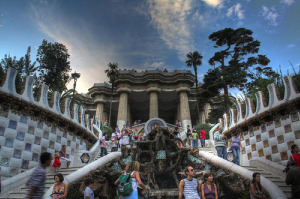
This park stands above the city and contains a series of curving walkways and paths. At the top, curved stone benches adorned with colorful mosaics offer a perfect resting place to sit and take in a view of the city.
Park Güell is a perfect example of Gaudi’s ordered chaos. Every aspect of the park over-stimulates, but it still exudes calm.
Casa Batlló
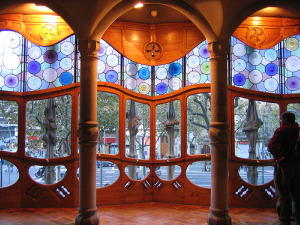
Gaudi remodeled this private home from the inside out.
From the arched roof to curved windows that gave the structure its nickname “House of Bones,” this building contains almost no straight lines. Every room boasts magnificent coloring and tiling.
>> Read about budget airlines that fly to Barcelona
>> Check out free things to do in Barcelona
Beijing, China
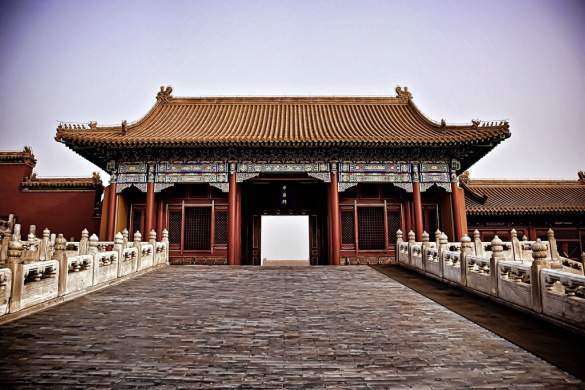
In Beijing, the slew of construction for the 2008 Summer Olympics gave shape to an emerging national identity. China wanted to prove it had more to offer the world than its ancient culture and architecture. And so the world watched as Bejing built Western-inspired buildings that went above and beyond the limitations of Chinese architecture.
Now, Beijing is home to a collection of both traditional and contemporary buildings.
The traditional style reflects Chinese beliefs and ethics of symmetry. These buildings give attention to decorative details, are built outward (not upward), and major construction materials include timber columns, beams and brackets.
The buildings Beijing built for the Olympics completely challenge the city’s own style of architecture. Beijing’s new construction is tall and asymmetric. Instead of creating an image of calm and focusing attention inward, both the exteriors and interiors of Beijing’s new construction aim to grab attention and awe viewers.
Great Wall of China
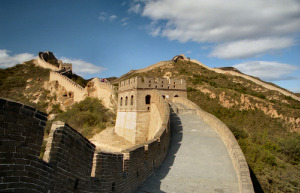
The expansive wall is more than 2,000 years old and extends almost 9,000 kilometers (5,500 miles).
Over centuries, different dynasties reinforced and extended the wall that protected the country from multiple invasions. The wall is a symbol of China’s rich history, and is a must-see for visitors to Beijing.
Forbidden City

Although Beijing’s Forbidden City is now overrun with tourists and vendors selling kitschy souvenirs, it is still an important monument to traditional Chinese architecture and culture. For centuries, this was the home of Chinese emperors and their governments.
Almost every aspect of the Forbidden City’s construction – from the colors to the number of statues to the symmetry – was intentional, which represents how important symbolism was to Chinese architecture.
CCTV Headquarters
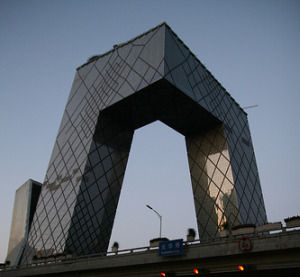
To complete construction on the new headquarters of China Central Television, architects had two engineering hurdles to jump.
The skyscraper stands in a seismic region. And two L-shaped towers leaning at 90-degree angles form the top and bottom of the building.
With 51 floors, it’s short for a skyscraper, but impressive because of its precarious-looking construction and asymmetry.
>> Look for cheap flights to Beijing
>> Learn about visiting Hong Kong on a budget
>> Check out these tips for having an indie travel experience in Beijing.
Istanbul, Turkey

Istanbul is located on both the continents of Europe and Asia. Most citizens practice Islam, but the city also claims strong Christian and Jewish communities. Istanbul is thus known as a cultural melting pot, and the city’s architecture certainly lives up to that reputation.
Visitors to Istanbul will find more than 2,000 mosques, 100 churches and 20 synagogues. Over time, Istanbul has served as a capital for Roman, Byzantine, Latin and Ottoman Empires, and is now Turkey’s capital. Each period built a new architectural layer on top of the old, and many of these monuments remain intact.
The Ancient Romans and Greeks left their aqueducts and the Walls of Constantine. The Byzantines and Genoese left their domed churched with arches. The Ottoman Empire left its castles, palaces and mosques. And the European Baroque styles and Art Nouveau palaces and mansions that followed add more to the eclectic landscape of Istanbul.
Hagia Sophia
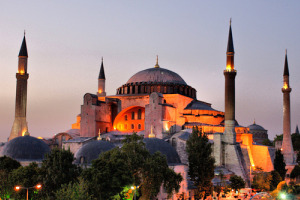
This museum was once a church and then a mosque. Hagia Sophia, also known as the Church of the Holy Wisdom, is most known for its unique dome.
Thanks to the dome’s umbrella shape, its weight rests on the pendentives between the 40 windows along its base. Light shines through the windows from all directions, which gives the impression that the dome is hovering. This pendentive dome was a Byzantine invention.
Blue Mosque
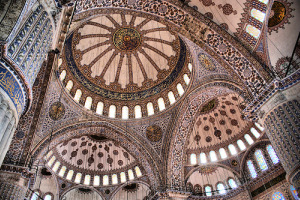
Six minarets towering over the skyline of Istanbul make it easy to locate the Blue Mosque. On closer inspection, visitors can also observe a series of cascading domes on the building’s exterior.
Inside, the walls and ceiling are lined with more than 20,000 handmade blue ceramic tiles, which give the mosque its name. The massive mosque can hold up to 10,000 people, and was built to out-do Istanbul’s most famous church at the time, Hagia Sophia.
Column of Constantine
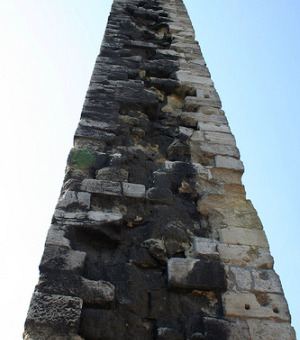
When Constantine the Great declared the city the capital of the Roman Empire in 330, he built this commemorative column.
The original was 50 meters tall, had a statue of Constantine dressed as Apollo at top, and was said to contain several Christian relics.
Natural disasters have weathered the column and a fire in 1779 left black scorch marks on its sides. Today the column stands 35 meters tall and is a symbol of the Roman empire in Istanbul.
>> Find hostels in Istanbul
>> Search for cheap airfare to Istanbul
>> Read about 10 experiences not to miss in Turkey
Chicago, USA
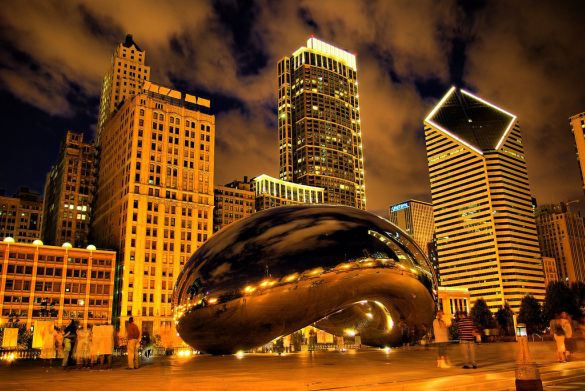
Unlike many cities on this list, Chicago is not a city with a long-established architectural history. The Great Chicago Fire of 1871 destroyed most of the city’s buildings, and the Chicago that stands today was built afterward. This city makes the list because the skyscraper was born here.
Architect William Le Baron Jenney is generally credited with the first skyscraper, a ten-story building that stood in downtown Chicago. Unlike the brick and stone buildings of the time, this one was built with cast iron, wrought iron and steel. The so-called skeleton construction was a system of beams and columns that allowed for a multi-story framework and invited the development of safer elevators, central heating systems, and further developments in steel construction.
With these advancements, competition between Chicago architects led to taller and taller skyscrapers. In addition, Louis Sullivan’s Chicago School of Architecture and Frank Lloyd Wright’s Prairie School of Architecture were born here – just two styles that have given Chicago an even bigger name in the world of architecture.
One of the most convenient ways to learn and see the most about the city’s architecture is to take a Chicago boat and architecture tour. Several companies operate these tours along the Chicago river.
Willis Tower, formerly Sears Tower

Willis Tower dominates the Chicago skyline as the tallest and most iconic building in the city. Sears, Roebuck & Co., financed the skyscraper’s construction and built it to house their employees.
The renamed Willis Tower now houses various offices and businesses and its skydeck ledge on the 103rd floor is a popular tourist destination. The ledge is actually an enclosed glass box that extend 4.3 feet from the building so that visitors can see 1,353 feet straight down.
Frank Lloyd Wright Home and Studio
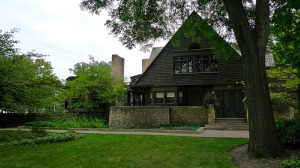
Frank Lloyd Wright revolutionized the art and architecture of the 20th century, and it’s worth the short trip to the suburbs to see where he lived and worked for the first 20 years of his career.
It was in his Prairie-style studio that he designed 125 structures, including such famous buildings as the Robie House, the Larkin Building and Unity Temple.
Cloud Gate
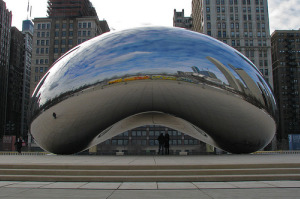
One of the most popular attractions for both locals and tourists in Chicago is the Cloud Gate, which reflects 80% of the city’s skyline on its surface. This interactive sculpture is essentially a giant stainless steal bean that acts as a mirror.
Spectators can see their images distort as they walk all around the sculpture or underneath its 9-foot arch. The best viewing time is at night, when the lights from Chicago skyscrapers illuminate the bean’s surface.
>> Discover the best observation decks in the world
>> Look for cheap flights to Chicago
>> Find things to do in Chicago
Dubai, United Arab Emirates
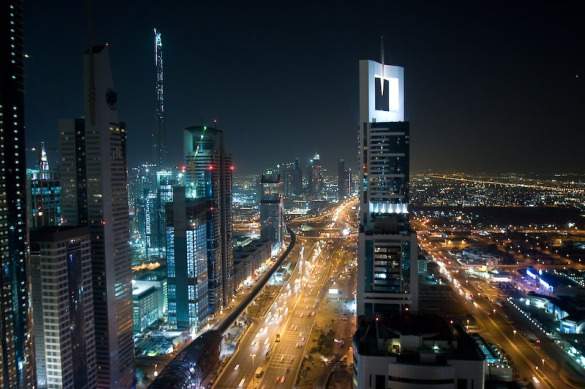
Although Chicago gave birth to the skyscraper, in recent years Dubai has been the city to master constructing these tall and extravagant buildings.
Dubai’s economy was initially built on oil, but its oil reserves have already been significantly depleted and only account for a small percentage of the economy. So the government recently decided to reinvent its image as a major international hub of commerce.
A wide-scale real estate boom followed, which completely changed the city’s landscape in a short period of time. Dubai now houses some of the tallest and most contemporary and ambitious architecture in the world.
More construction is in the works despite rumors that it lacks sufficient financing. New construction is so prevalent in Dubai that reports claim the city houses between 15 and 25 percent of all the world’s cranes.
Burj Al Arab

This luxury hotel is the only self-proclaimed seven-star hotel in the world. The building exterior is meant to represent Dubai’s transformation and resembles a sail.
The hotel actually rests on an artificial island 280 meters from the shore and is connected to the mainland by a bridge. As you would guess, rooms here aren’t cheap. Suites start at $2,000 per night and can cost as much as $28,000.
Burj Khalifa

As of 2010, this skyscraper is the tallest man-made building ever built. The $150 billion building has 160 floors and stands at 828 meters (2,717 feet) high.
That’s 52 floors more than Chicago’s Willis Tower and 320 meters taller than Tawain’s Taipei 101, which was formerly the world’s tallest building.
The Burj Khalifa also boasts the world’s highest mosque, the world’s highest swimming pool, and it is the tallest free-standing structure in the world.
The World

This archipelago of 300 man-made islands was constructed with sand dredged from the sea. Fresh water, utilities and power are routed underwater to the islands.
The islands are meant to look like a map of the Earth and can be seen from space. Private buyers can purchase individual islands for $15 – $50 million.
>> Book flights to Dubai
>> Find budget hotels in Dubai
Athens, Greece
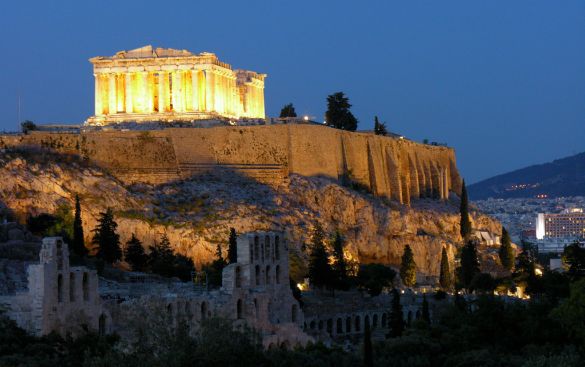
Athens is a city for travelers who are drawn to architecture with clues about the culture and lifestyle of people of the past. The Ancient Greeks were political, religious, and proud. They built many monuments to celebrate victories, to give honor to the deities, and to stroke their own egos.
Greek architecture is often associated with temples and columns. The Doric, Ionic and Corinthian orders designed by Ancient Greek architects have proved to be timeless and are apparent in many of the buildings that still stand in Athens today. The friezes and sculptures housed in Athens temples provide insight into the lives and worship practices of the Athenians of yesteryear. They depict battles, processions, important statesmen, and deities.
Parthenon

This temple to the Greek goddess Athena was finished in 432 BC and is the most important surviving structure remaining from Ancient Greece. It still stands even after 2,500 years of weathering, war, and vandalism.
The Parthenon is an art history teacher’s dream, complete with columns of both the Doric and Ionic order, metopes depicting various battles, pedimental sculptures, and a frieze.
Temple of Athena Nike
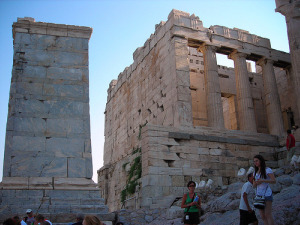
Although this temple is the smallest on the hill, it is the first to greet visitors to the Acropolis of Athens. The height-to-diameter ratio of its columns is unusual; it is 7:1, whereas most Ionic buildings are 9:1 or 10:1.
The Temple of Athena Nike was built with marble and was a place to worship gods and goddesses of war. Fragments of the original frieze are housed in the Acropolis Museum and copies rest in their place inside the temple.
Temple of Olympian Zeus
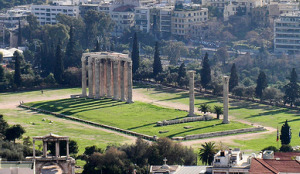
Only the ruins of this once grandiose temple remain, but it still represents the power and pride of past Athenian rulers. Various rulers sought to finish the temple to their own governments and themselves, but death and war prevented its completion.
The temple was finally dedicated in 132 AD, several centuries after constructions first began. But it was badly damaged and pillaged shortly after, and was never fully restored.
>> Plan your trip with our Greece travel guide
>> Book ferries in Greece
>> Discover off the beaten path spots in Greece
Rome, Italy
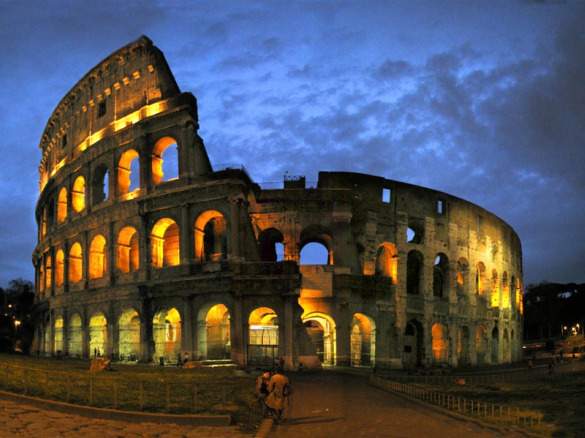
The Romans made alterations to Greek and Etruscan architecture to create a new style that was practical and creative. You can still see much of this style in the Italian capital of Rome.
For example, the Romans used arches, concrete and bricks to build the aqueducts that supplied water to their densely populated city. Visitors to Rome can also observe numerous domes, which the city’s architects used to fortify ceilings and expand the interior space of buildings, as best seen in the Pantheon.
The Romans revolutionized construction with the introduction of concrete as a primary building material. They found it was cheaper and stronger than the previously popular marble. And of course, it was the Romans who perfected the amphitheater.
These multi-purpose structures display the complexity of Roman architecture because they combine many of their advances at once. And, like much of Roman construction, the amphitheaters were not only functional, but also aesthetically pleasing.
Pantheon
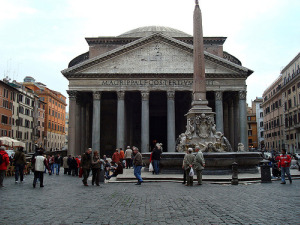
The Pantheon that stands today is not the original, but it is still an architectural marvel of its time and is the best-preserved building in Rome. This was the first temple to combine concrete construction with the classical Greek columns.
In addition, the giant 142-foot dome was the largest in existence until 1960. The dome is still impressive. The distance from the top of the dome to the floor is equal to its diameter.
Colosseum
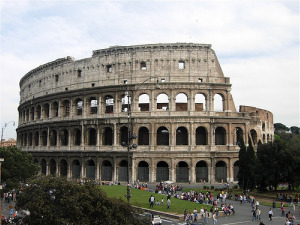
The Colosseum is a remarkable monument because of its practical and efficient architecture. It could seat up to 50,000 people and had about 80 entrances so many people could enter and leave at once. The Colosseum was equipped for a variety of performances such as battle reenactments, theater, executions and mock sea battles.
The structure has been damaged by earthquakes and robbers, but its remains still represent the architectural prowess of the Romans.
Aqueducts

The Romans built 11 aqueducts to bring bathing and drinking water to their densely populated city. Tunnels and several tiers of arches helped direct the flow of water for long distances and over rocky terrain.
Roman architects dedicated an enormous amount of planning to the construction of each aqueduct to determine the length, size and grade needed.
>> Book flights to Rome
>> Find out where to stay in Rome
>> Get tips for your first visit to Rome
What’s your favorite architecture-rich city? What great building did we leave off the list? Share your thoughts in the comments section at the end of this article.
Further Reading
- 12 of the Most Beautiful Bridges in Europe
- 11 of the World’s Coolest Train Stations
- The World’s Best Cities for Viewing Street Art
- 8 Paintings Every Traveler Should See
photo credits: Barcelona 1, 2, 3, 4 – Beijing 1, 2, 3, 4 – Istanbul 1, 2, 3, 4 – Chicago 1, 2, 3, 4 – Dubai 1, 2, 3, 4 – Athens 1, 2, 3, 4 – Rome 1, 2, 3, 4